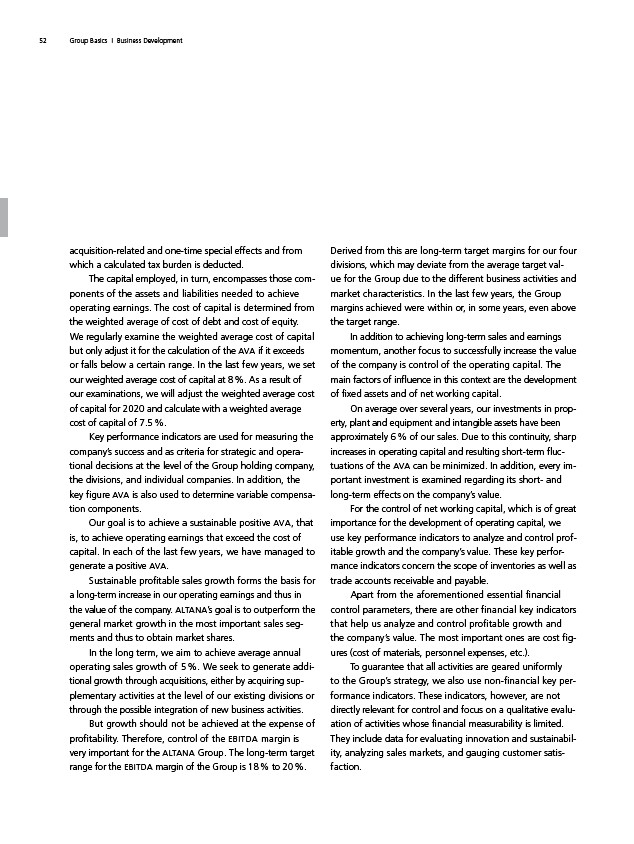
acquisition-related and one-time special effects and from
which a calculated tax burden is deducted.
The capital employed, in turn, encompasses those components
of the assets and liabilities needed to achieve
operating earnings. The cost of capital is determined from
the weighted average of cost of debt and cost of equity.
We regularly examine the weighted average cost of capital
but only adjust it for the calculation of the AVA if it exceeds
or falls below a certain range. In the last few years, we set
our weighted average cost of capital at 8 %. As a result of
our examinations, we will adjust the weighted average cost
of capital for 2020 and calculate with a weighted average
cost of capital of 7.5 %.
Key performance indicators are used for measuring the
company’s success and as criteria for strategic and operational
decisions at the level of the Group holding company,
the divisions, and individual companies. In addition, the
key figure AVA is also used to determine variable compensation
components.
Our goal is to achieve a sustainable positive AVA, that
is, to achieve operating earnings that exceed the cost of
capital. In each of the last few years, we have managed to
generate a positive AVA.
Sustainable profitable sales growth forms the basis for
a long-term increase in our operating earnings and thus in
the value of the company. ALTANA’s goal is to outperform the
general market growth in the most important sales segments
and thus to obtain market shares.
In the long term, we aim to achieve average annual
operating sales growth of 5 %. We seek to generate additional
growth through acquisitions, either by acquiring supplementary
activities at the level of our existing divisions or
through the possible integration of new business activities.
But growth should not be achieved at the expense of
profitability. Therefore, control of the EBITDA margin is
very important for the ALTANA Group. The long-term target
range for the EBITDA margin of the Group is 18 % to 20 %.
Derived from this are long-term target margins for our four
divisions, which may deviate from the average target val-
ue for the Group due to the different business activities and
market characteristics. In the last few years, the Group
margins achieved were within or, in some years, even above
the target range.
In addition to achieving long-term sales and earnings
momentum, another focus to successfully increase the value
of the company is control of the operating capital. The
main factors of influence in this context are the development
of fixed assets and of net working capital.
On average over several years, our investments in property,
plant and equipment and intangible assets have been
approximately 6 % of our sales. Due to this continuity, sharp
increases in operating capital and resulting short-term fluc-
tuations of the AVA can be minimized. In addition, every important
investment is examined regarding its short- and
long-term effects on the company’s value.
For the control of net working capital, which is of great
importance for the development of operating capital, we
use key performance indicators to analyze and control profitable
growth and the company’s value. These key performance
indicators concern the scope of inventories as well as
trade accounts receivable and payable.
Apart from the aforementioned essential financial
control parameters, there are other financial key indicators
that help us analyze and control profitable growth and
the company’s value. The most important ones are cost figures
(cost of materials, personnel expenses, etc.).
To guarantee that all activities are geared uniformly
to the Group’s strategy, we also use non-financial key performance
indicators. These indicators, however, are not
directly relevant for control and focus on a qualitative evaluation
of activities whose financial measurability is limited.
They include data for evaluating innovation and sustainability,
analyzing sales markets, and gauging customer satisfaction.
52 Group Basics I Business Development